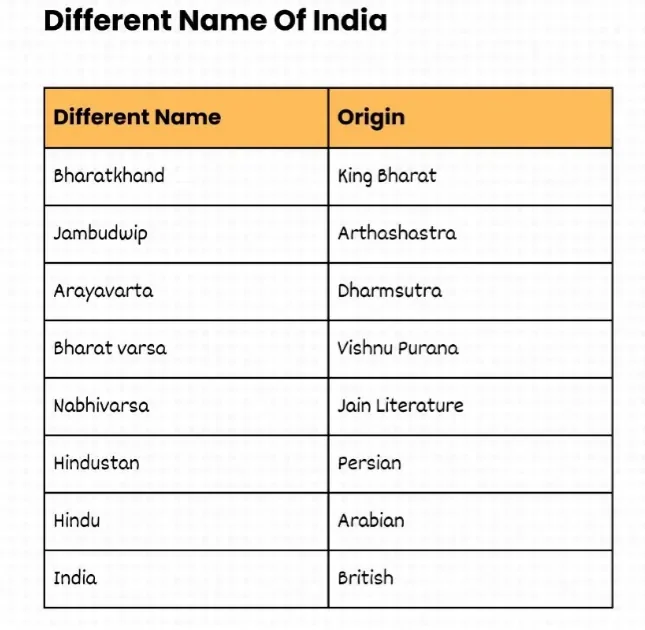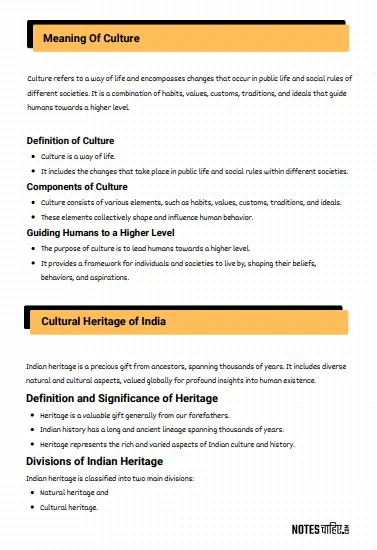Today we will provide you with the complete chapter notes of GSEB Class 10 Board Chapter 1 Heritage Of India. We have covered the heading of the chapters.
Each heading will get a subheading that we often say Key points. At the very end, we have also created MCQs for you so that you can try your learning soon.
FAQs will provide you with the questions from last year’s exam board. The best thing about this note is that you can download it in PDF form because we will soon upload the eBook Of
GSEB Class 10 Ch1 Guide For Heritage Of India Solution
Introduction: Heritage Of India
The chapter starts with a verse from Vishnu Purana explaining the geographical extent of India, the Influence of Indian culture, transfer and progress of heritage.

- Geographical Extent of India
- India extends from the Himalayas in the north to the Indian Ocean in the south.
- The scripture “Vishnu Puran” mentions this geographical boundary of the country.
- Influence of Indian Culture
- Indian culture has attracted people from different countries, who have come to trade, settle, and mingle with the Indian culture.
- This mutual exchange has led to changes in Indian culture over time.
- Transfer and Progression of Heritage
- The heritage of Indian culture is transferred from generation to generation.
- Indian culture has continuously progressed through the assimilation of various influences.

Rich and Varied Heritage
- Rich and Varied Heritage
- India possesses a rich and varied heritage that has influenced both the country and the world.
- The cultural values of “Sat” (truth), “Chit” (consciousness), and “Anand” (bliss) are realized through Indian culture.
- Exchange with Other Cultures
- Indian culture has prospered through the mutual exchange with other countries that came to India and settled here.
- The values of non-violence and peace have been accepted and admired by the world through this exchange.
- Contributions to Culture
- Throughout history, individuals in India, including scholars, thinkers, artists, artisans, sages, saints, scientists, and historians, have contributed to the growth and development of Indian culture.
- Nature of Culture
- Culture encompasses various aspects such as habits, values, customs, traditions, and the conduct of lifestyle.

Meaning of Culture
Culture refers to a way of life and encompasses changes that occur in public life and social rules of different societies.
It is a combination of habits, values, customs, traditions, and ideals that guide humans towards a higher level.
- Definition of Culture
- Culture is the embodiment of a way of life.
- It includes the changes that take place in public life and social rules within different societies.
- Components of Culture
- Culture consists of various elements, such as habits, values, customs, traditions, and ideals.
- These elements collectively shape and influence human behavior.
- Guiding Humans to a Higher Level
- The purpose of culture is to lead humans towards a higher level.
- It provides a framework for individuals and societies to live by, shaping their beliefs, behaviors, and aspirations.
Cultural Heritage of India
Write about cultural Heritage Of India class 10 point wise
Indian heritage is a precious gift from ancestors, spanning thousands of years. It includes diverse natural and cultural aspects, valued globally for profound insights into human existence.
- Definition and Significance of Heritage
- Heritage is a valuable gift inherited from our forefathers.
- Indian history has a long and ancient lineage spanning thousands of years.
- Heritage represents the rich and varied aspects of Indian culture and history.
- Heritage as a Precious Gift
- The school pledge reflects the love and pride for one’s country and its heritage.
- Heritage is considered a precious gift from India to the entire world.
- It offers insights into the mysteries of human life and the historical evolution of civilization.
- Divisions of Indian Heritage
- Indian heritage is classified into two main divisions:
- Natural heritage and
- Cultural heritage.
- Indian heritage is classified into two main divisions:
| Natural Heritage | Cultural Heritage |
|---|---|
| >Diverse natural landscapes >Unique flora and fauna | >Art and sculpture >Music and dance >Architecture and monuments >Literature and poetry >Traditions and customs >Spiritual practices |
(1) Natural Heritage of India
Natural Heritage of India
- India’s natural heritage comes from the close relationship between nature, the environment, and human life.
- Nature includes mountains, forests, deserts, rivers, trees, plants, flowers, insects, and landscapes.
- Indians have great respect and belief in nature, understanding its significance.
- Stories like “Panchatantra” and “Jataka Tales” show how nature is closely linked to Indian culture.
- Music in India, both classical and folk, draws inspiration from nature.
- Ayurveda, Unani, and Nature Cure are traditional medicine systems that use natural principles.
Landscapes
- Different landforms create stunning Indian landscapes.
- The Himalayas hold great importance for India, featuring snow-covered peaks, forests, and pilgrimage sites.
- The Terai forests and pilgrimage places like Amarnath, Badrinath, Kedarnath, and Nanda Devi are found in the Himalayan region.
Rivers
- Rivers have played a crucial role in the development and flourishing of Indian culture.
- Rivers like the Ganga, Yamuna, Sarasvati, Indus, Narmada, Godavari, and Krishna have deeply influenced the people of India.
- Rivers serve as sources of drinking water, irrigation, electricity, and transportation.
- River scenes at dawn and dusk inspire artists and enhance the aesthetic sense of the people.
Vegetation
- Indians have a long-standing love and affection for plants and trees.
- Trees provide food and support the livelihood of humans, animals, and birds.
- Certain trees like Banyan, Pipal, and basil are worshipped in India.
- Cereal crops, pulses, oilseeds, and medicinal plants have enriched the lives of people since ancient times.
- Medicinal plants and flowers like Harde, Neem, Rose, Lotus, Jasmine, and Sunflowers contribute to a beautiful and healthy life.
- Vegetation significantly influences social and religious life in India.
Wildlife
- India has a rich wildlife heritage and a culture that values animals.
- Tigers, lions, elephants, rhinos, foxes, bears, deer, snakes, and various other species are found in India.
- Some wild animals, such as tigers, peacocks, and eagles, hold religious significance and are associated with gods and goddesses.
- India’s national currency features the figure of lions, horses, and bulls.
- Wildlife reserves and protective laws are in place to safeguard and conserve the diverse wildlife.
(2) Cultural Heritage of India
Write about cultural Heritage Of India point wise
- Cultural heritage refers to the man-made contributions created or received by humans through their skills, wisdom, art, and craftsmanship.
- Various civilizations and influences, such as Aryans, Mughals, Britishers, have shaped the rich and diverse cultural heritage of India.
- The exchange of ideas, traditions, and influences has contributed to the development and richness of Indian culture.
Architecture and Sculpture
- Indian architecture and sculpture have a history of 5,000 years.
- The remains of the Indus Valley Civilization provide evidence of the ancient art forms in India.
- Figures of gods, goddesses, humans, animals, toys, and sculptures like bearded men and dancers highlight the artistic legacy of India.
- Examples of architectural marvels include the Mauryan Era statues of bullocks or lions on inverted Lotus, statues of Gautam Buddha, Kalkhand statues of Jain tirthankars, and the caves of Ellora.
Palaces, Buildings, and Historical Places
- India’s cultural heritage includes palaces, buildings, stupas, viharas, chaityas, temples, mosques, tombs, forts, and gates.
- Historical places associated with India’s freedom movement, such as Sabarmati Ashram, Dandi, Bardoli, Vardha, Shantiniketan, and Delhi, are considered part of the cultural heritage.
- These sites represent significant events and contributions to India’s struggle for independence.
Contributions and Discoveries
- India’s cultural heritage encompasses a wide range of contributions and discoveries.
- Language, script, the discovery of zero, mathematics, calendar systems, astronomy, iron, literature, religion, warfare strategies, chariots, political science, zoology, botany, Vastushastra (architecture), and environmental protection are some notable discoveries and contributions.
Download Heritage Of India Notes PDF 2023



Get This GSEB Board Paperset For Scoring Better In S.S

| Devsatya Paper Set – March 2023 |
|---|
| Aligned with New GSEB Board Paper Style |
| Includes 43 Question Papers for Main Subjects |
| Mathematics, Science, Social Science, Gujarati, & English |
| All Papers Follow GSEB’s Blueprint |
| Provides Answers for Short Questions and Mathematics Examples |
| Includes Question Paper Patterns for Sanskrit, Hindi, P.T., and Computer |
| Offers Tips for Board Examinations |
| High-Quality Paper with Comprehensive Content |
| Ideal for March 2020 GSEB Board Exams |


Leave a Reply